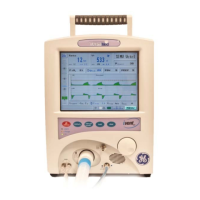184
2. If the ventilator has failed the VVT, verify that the flow sensor and
exhalation valve control tubes are adequately mated to the front panel
luer fittings, perform the calibration procedure (See Calibration, page
176) and repeat the test. If VVT failure persists, contact your authorized
service facility.
NOTE In the case that VVT fails, on each power up the ventilator posts an alarm pop-
up window that indicates a VVT must be done before it is put into use.
CONFIGURATION SCREEN
Use the Configuration Screen to adjust:
Default startup weight
Default start screen
Default FiO2 setting
To access the Configuration screen:
1. From the Main screen select Menu - Maintenance.
2. A red Caution pop-up window appears. Select Yes.
3. The Maintenance menu appears. Select Configuration Screen.
WARNING Several functions on the Configuration Screen are designed only as
service indicators and are not accessible. Do not attempt to change
any settings on the iVent
TM
201 unless you are certain of the options
you intend to alter. Make sure settings are in accordance with
standard protocol within the hospital or patient facility.
CHOOSING A DIFFERENT STARTUP SCREEN
Use the Default start screen option if you would like the iVent
TM
201 to power up
with a different screen.
To set the startup screen:
1. From the Configuration screen dial the Control Knob to select Default
Start screen, then press the knob to confirm.
2. A menu pop-up window appears and shows Main, Monitoring, and
Home Care screens. Select the required screen, and press the knob to
confirm.
NOTE Not all screens are operational in all iVent
TM
201 models.

